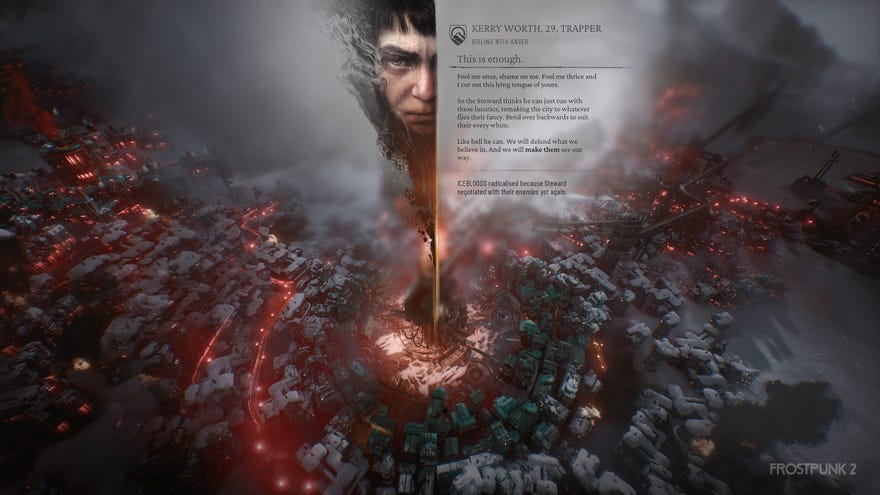In Frostpunk 2, it's not the cold that's your enemy, but human nature
An early look at 11 bit Studio's ambitious survival sequel
In the frozen hellscape of Frostpunk, you eked out your existence in hours and days, clinging to your heat- and life-giving generator at the centre of your fledgling city like there was literally no tomorrow. In 11 bit Studio's forthcoming sequel, Frostpunk 2, the apocalypse is yesterday's news. Now you're dealing with "what happens when you survive the un-survivable," as the game's co-director and design director Jakub Stokalski neatly puts it when I sit down for a hands off presentation at this year's Gamescom. And to do this, Frostpunk 2 is going big, measuring its time not in days, but weeks, months and even years.
"If we want to show the evolution of societies and different utopias/dystopias, we need breathing room," says Stokalski. "And this breathing room really is in the scale, both in the physical sense but also in the sense of time. It's difficult to show meaningful social change in the space of a month, so the time ticks now in weeks and months, and in a long playthrough you'll get up into years, so you can see the consequences of your choices."
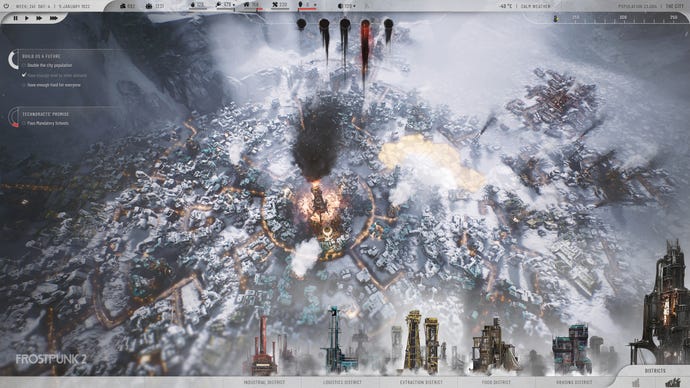
What I'm actually looking at is Frostpunk 2's Utopia Builder mode, which is essentially their version of an endless sandbox experience where you just keep trying to survive for as long as possible. When it launches next year, it will, of course, have its own story-driven scenario mode much like the first Frostpunk game, which picks up 30 years after the events of the first game, Stokalski tells me, and explores what happened to the city of New London after they made it through the world-ending mega storm at the end of Frostpunk 1. Alas, Stokalski isn't ready to reveal much more about the story mode just yet, so we'll have to wait until a later date to hear more. However, there's still plenty of things to glean from its Utopia Builder mode, and I reckon it gives us a pretty clear picture of what we can expect from its story mode at launch.
As hinted at above, this is a game of vast scale, where construction now takes place across districts instead of plonking down individual buildings, and where its ant-like citizens now whizz through the streets at lightning speed, their handheld lamps and torches streaking through the city's frosty warrens like a sped-up timelapse of nighttime car headlights. Indeed, with time now running across weeks and months in Frostpunk 2, Stokalski says it would be strange to issue objectives such as 'go and gather 100 wood' to construct an individual building. Hence the move to building these larger regions of the city, which will be split into different types such as housing, food, logistics and extraction districts.
In fact, the central district I can see onscreen during my demo session is more or less what you might end up with at the end of a successful run in Frostpunk 1. The difference here, however, is that this central district is just one of many on display, with the city stretching out into the snowy wilderness like long, metal tentacles. Some of this scale, naturally, comes from the fact we're looking at its 'endless' Utopia Builder', but I do get the sense that the main campaign will be similarly expansive.
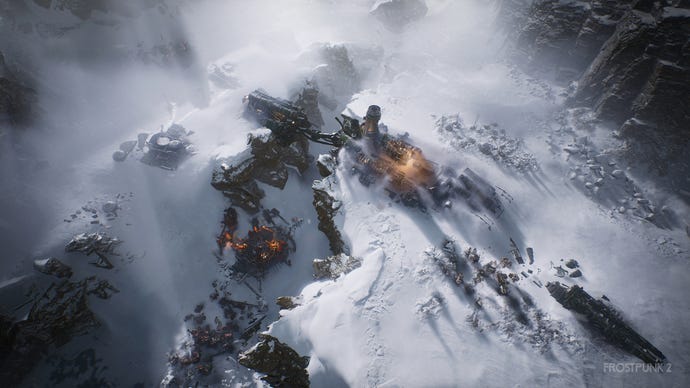
"We really changed the whole economy system, so it's now based around supply and demand," Stokalski explains. "When you build something, you get something out of it. If you build a housing district, our people have more shelter, but the same housing district requires people to maintain it and more importantly, a constant supply of resources to run, fend off the cold and the decay and all of that. This balancing act is really what construction and expansion is all about."
Does this mean that Frostpunk 2 has lost its defining survival systems? Not as such, says Stokalski, but they've definitely been shifted more toward the background as a result. "The survival pressure is still there," he says, and you'll still need to heat your city, upgrade the generator and manage how much heat it outputs. Likewise, you can still die from cold, starvation and disease if you don't manage your resources correctly. "But social survival is even more important," he continues, "so out of mismanaged ambitions comes tension and conflict," which is represented by smoky, almost oily tendrils around the edge of your screen.
It's a similar rhythm to old Frostpunk, then, just from a larger, more macro perspective. The placement of your districts "matters", too, he says, as there will be a proximity system at play that rewards efficiency, such as placing housing next to the generator, but penalises you if you, say, put housing next to a more industrial zone.
Within these districts, though, you can place special buildings that let you access certain features and technologies, such as the Idea Tree, which is unlocked by building the Research Institute. This tree is a similar, well, idea to the first game's Book Of Laws, as exploring these notions of survival will help to shape the direction your city can take over the course of the game. For the sequel, though, Stokalski says, "It's really about exploring different avenues, different problems, but more importantly, different answers, really, to problems that your city might face," rather than simply picking one route or another like in the first game.
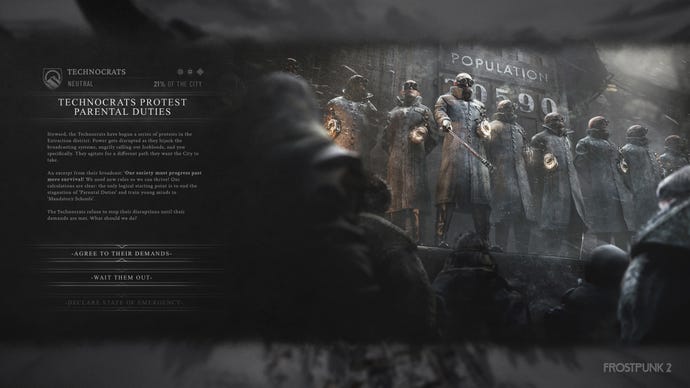
To illustrate, he starts to tell me about two of the core factions that have emerged since the events of Frostpunk 1: the Foragers and the Engineers. As their names might suggest, the Engineers are descendants of the people who built the generator in Frostpunk 1. Technology is king for this lot, while the Foragers believe that relying on anything other than ourselves will only lead to disaster. "Exploring what happens to these communities and how these can spiral out of control a bit is at the heart of the game," Stokalski says, alluding to the game's tag line: "The city must not fall."
"If we ask the question of 'how do we produce more food in our city?', depending on who you ask, you might get a slightly different answer," he says. "If you ask the Engineers, they'll be like, 'You should totally come up with some ingenious process, for example, chemical fertiliser, that will enable us to scale up production.' But if you ask the Foragers, they're like, 'Well, we can't grow dependant on any one particular process, let's use something that's always available, time-proven and it works, so let's use human waste.'"
At first glance, this will all feel very familiar to those difficult Book Of Law decisions we made before, and Stokalski chooses to pursue the Foragers' idea of a Hothouse building rather than listen to the more technologically minded Engineers. "What's important is that there are not bad and good answers," he says. "All of these have their pros and their cons, and it's up to you how you want to shape the technological landscape you're building."
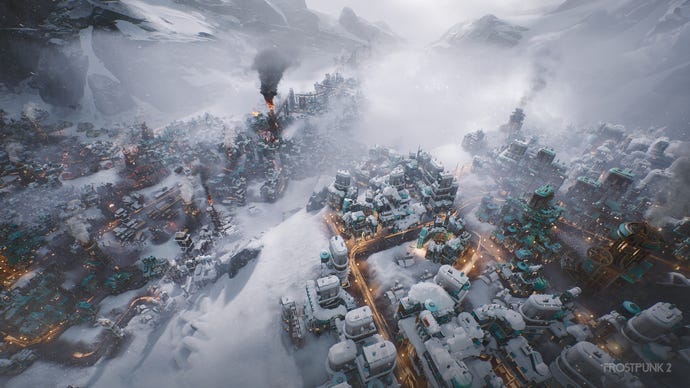
What's new is that it's not just you calling the shots anymore. To pass laws relating to broader issues and tensions relating to the city's overall equality, such as 'what to do with the city's children' (as some have been roped into working in these Hothouses while others are out playing and studying, we find out from clicking on one of the citizens and hearing their thoughts on the matter), we must pay a visit to the new Council Hall. Stokalski calls this "the most important special building that we have in the game" - even more so, perhaps, than the generator itself. Indeed, the days of being able to justify anything to ensure your people's survival "are long gone", he says, and the people now "expect to be heard in how the city is run, what the rules in the city are, and how it's going to be shaped."
Inside the Council Hall, the city's various groups can vote on certain motions, which are grouped into four categories: Economy, Society, Rule and Survival. Each of them will fill up with the ideas you choose to explore in the Idea Tree, and each group will have its own amount of sway and influence depending on their size the issue at hand. Immediately, you can get a good glimpse of those for and against by looking at the number of lightbulbs lit up on its circular, top-down benches, and if you've built up enough Trust as a leader, you'll be able to 'spend' it to influence certain groups and sway them to your cause. Others may want something else in return if you them to go along with you, and failing to follow through or reneging on these promises will have big consequences, Stokalski says, warning that "you can quickly get to something that we like to call a prisoner of your own choices."

Again, there are still hints and echoes of Frostpunk 1 here, ensuring its spirit is still intact, even on this kind of larger scale. Similarly, as time progresses, zeitgeists can emerge in your city as well, leading to the birth of newer factions who have even more radical views than the Foragers and Engineers. After a quick time skip of two years, for example, Stokalski gives me a quick glimpse of the Ice Bloods (ultra Foragers) and the Technocrats (mega Engineers) who will each have different views again on the issues you've previously debated. They'll come forward with their own ideas and interpretations, continuing the debate long after that initial council vote.
"We're continuing to make a society survival game like Frostpunk 1, but we hope you'd agree by now that what we're trying to do is move it to a slightly different level," Stokalski says. "If we say that Frostpunk 1 was about surviving nature and whatever it can throw at you, then Frostpunk 2 is really about this observation that we can only come together so far to overcome the obstacles in front of us, and that ultimately the biggest enemy is always human nature."
Unfortunately, that was where my demo presentation ended, and so I've yet to see exactly what kind of nuisances these radical groups might become further down the line. But I left my demo presentation excited for what's to come, as the size and scale of Frostpunk 2 not only looks more ambitious than its predecessor, but the evolution of its sociological problems also feels a lot greyer and more nuanced than the binary choices we faced before. "This time around the storm is internal," Stokalski concludes, and on this point at least, I'm definitely inclined to agree.
For more of the latest news and previews from Gamescom 2023, head to our Gamescom 2023 hub. You can also find everything announced at Opening Night Live right here.
